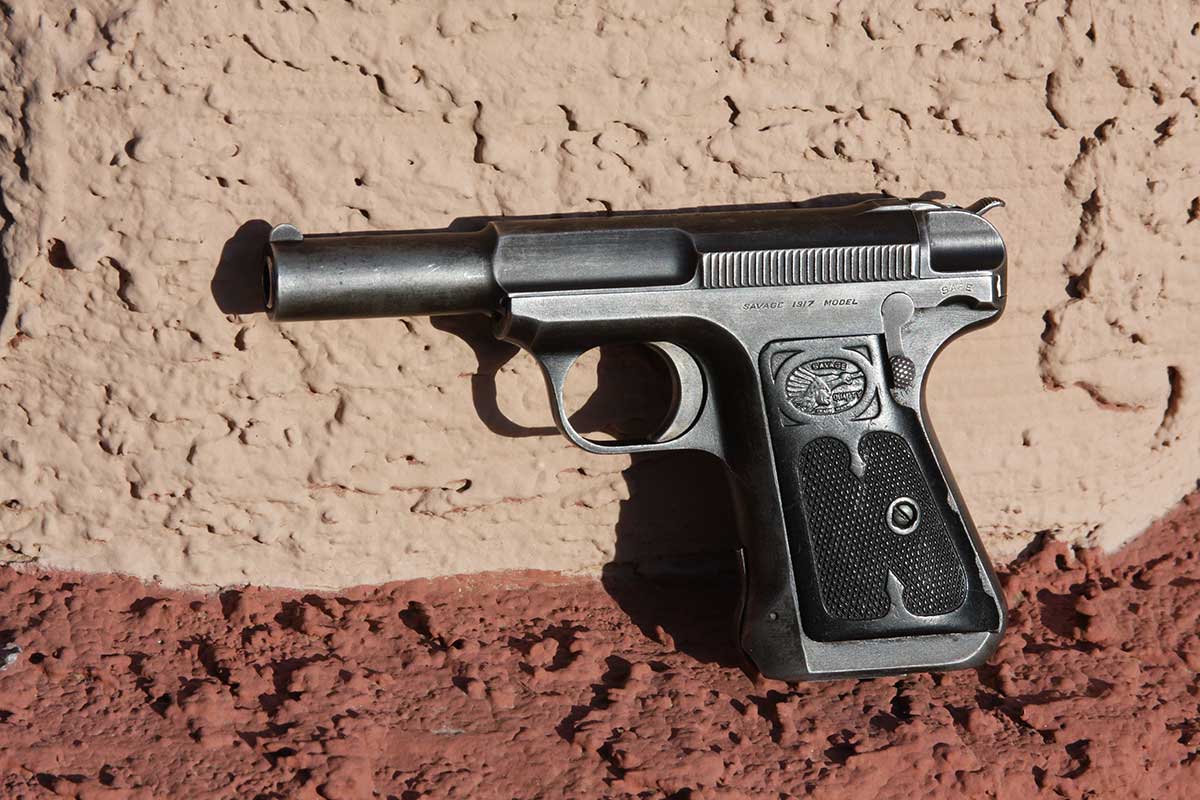
AC020821-Relic-Rescue-R-1-800
In the category of “Non-Fake News,” gun sales in the last two years have broken all previous records. Many of these guns have been sold to first time gun buyers suggesting that more Americans now believe that our government may not be able (nor inclined) to protect them in the new, not-so-peaceful America.
Perhaps they’ll remember who inspired these fears when the next election rolls around.
As a gun buyer/trader with many decades under his belt, I also made several purchases during the last couple of years, but not because of 21st century panic attacks. I spend a lot of time at Gunsite Academy with that institution’s world famous focus on self-defense training using firearms, so the concern for being able to protect myself and family is always in my mind.
Eventually I look at every gun in terms of its potential to fulfill that defensive mission. That said, I am also a notorious “impulse buyer” with an appreciative eye for older, interesting guns.
In a recent visit to Mazy’s Guns near Gunsite Academy to buy some cigars (yes, it’s also a cigar store with a humidor room,) I noticed a “never-saw-one-before” 1917 Savage pistol in .32 ACP. Since I was carrying a 1911 at the time, it’s not like I needed the gun to make it safely back to my truck. Unfortunately my mis-spent youth and lack of will power kicked in and I walked out the door with both the Savage and a box of cigars. It wasn’t until later that I gave some serious thought to the little semi-auto for defensive purposes.

If the safety lever is moved to the horizontal position while the slide is manually held to the rear, the safety lever becomes a slide lock. The slide does not lock open automatically after the last shot.
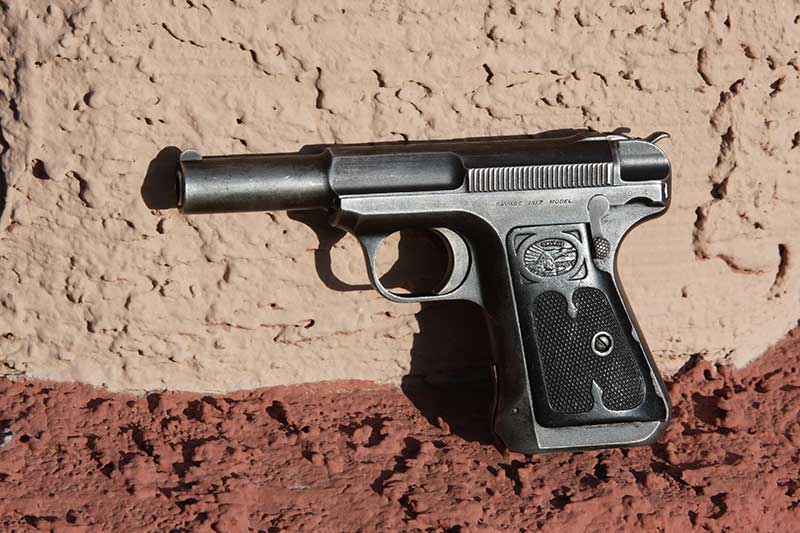
Savage Model 1917 has aged beautifully almost showing off the fine patina acquired over the last century. Careful fit of all parts is clearly visible along with all the lettering applied before leaving the factory.

With the gun cocked and safe, the safety lever on the left side of the frame is in the horizontal position much like 1911.
The Savage is a semiautomatic blow-back pistol as opposed to many of today’s handguns with a locked breach. It’s a quite common design even now with semi-auto pistols chambered for the lower power cartridges like .380 ACP, .32 ACP and .25 Auto. Like all guns of the early 20th century, the Savage is all steel with the exception of the grip panels. Today’s shooters would view it as unnecessarily heavy, particularly if it’s to be carried concealed.
The grip frame is disproportionately large; distance from front strap to back strap at the base of the frame is almost double the length of the magazine base. To me, it’s definitely not a candidate for pocket carry. But while it’s larger than needed for concealment, the hand-filling grip is appreciated when you’re ready to shoot. Slide and barrel shroud are one piece machined from a single piece of steel with vertical serrations at the rear of the slide to facilitate manual operation. Working the slide is much easier if the hammer is cocked first.
The gun features an external safety lever
in roughly the same position as a 1911
that also functions as a slide lock.
The gun has an external hammer attached to which is a long firing pin that moves rearward with the hammer when the gun is cocked and forward when fired. The Savage is the first gun I’ve seen with this feature as opposed to the internally mounted, spring operated firing pins on the more modern guns I normally shoot.
The rear sight consists of a short rib that’s an integral part of the slide with a “U” shaped notch. It has parallel sides making it more visible and easier to use than the “V” shaped notches on other old Peacemakers. The rear sight can be seen with the hammer down but is more visible when the gun is cocked. The front sight is an inverted V that is remarkably visible when properly aligned with the rear notch.
Trigger pull is quite heavy averaging nine pounds eight ounces when measured on my Lyman trigger gage. Offsetting that is the short, narrow trigger which allows you to get more finger on the trigger thus letting you apply more pressure before you start to tremble. Since it is single-action only, the trigger only has to move a short distance before the hammer falls. For maximum accuracy in a handgun, I’m a big fan of single-action vs. double-action triggers.

The only sure way I could operate the combination safety/slide lock lever was to raise my right hand thumb and move it using my support hand thumb.

Releasing the magazine took more manual dexterity than any of the more modern pistols I’ve handled over the years. That said, the magazine slid easily and smoothly in and out and locked in solidly with a gentle push.
I had difficulties in operating the Savage’s controls. The gun features an external safety lever in roughly the same position as a 1911 that also functions as a slide lock. When the safety rotated downward into the vertical position, the gun is ready to fire. Rotating the lever upward to the horizontal position with the gun loaded and cocked activates the safety and prevents the hammer from falling.
With the gun empty, pulling the slide back and rotating the safety lever upward to the horizontal “safe” position locks the slide to the rear. The slide does not lock open when the last round is fired. The end of the safety lever has a raised rounded surface that is checkered making it easier to engage with the side of your thumb.
I had trouble “wiping” the safety lever off with the thumb of my shooting hand. It was easier for me to raise my right thumb exposing the safety and use the thumb of my left hand to push it down. At a recent writers’ event at Gunsite, the Savage and I spent some range time with Rangemaster Lew Gosnell. While he acknowledged that the safety lever system is more complicated and difficult to operate than typical modern pistols and the 1911, he had no trouble sweeping the safety off with the thumb of his shooting hand.
The Savage’s magazine release lever is also like nothing I’ve used before. Located at the bottom of the front strap, the tip of the one inch long lever can be reached by the pinky finger of the shooting hand, but I couldn’t apply enough pressure to release the magazine. By moving my pinky out of the way, I could reach in with either the thumb or forefinger of my left hand and depress the lever sufficiently enough so that gravity allowed the mag to drop smoothly from the mag well.
Once a proper manual of arms was learned, I was quite impressed with how smoothly the magazine slid in and out of the grip frame on this 100 year old pistol.
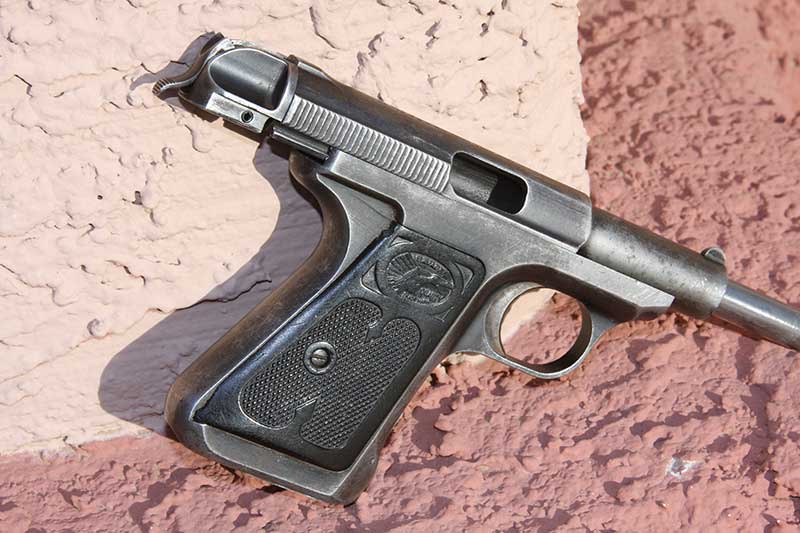
Given the small ejection port with minimal operating real estate I was amazed that the pistol was still functioning reliably, particularly after all these years. Ammo selection is critical as mentioned in the article.

Base of the grip frame was nearly twice as wide as the magazine depth resulting in an unusually hand filling grip for this size pistol. Note the small mag release lever fitted into the bottom of the front strap.
As everyone’s aware, we are experiencing an extreme shortage of ammunition nation-wide. A friend came up with a couple partial boxes of old .32 ACP ammo. For the first two magazines fired (I only have one magazine with a max capacity of ten rounds,) the Savage functioned flawlessly. That was using some fairly modern (red box) of Federal 71-grain FMJs. When I switched to some older ammo, I’d could fire around 3-6 rounds before experiencing a malfunction. Certainly not the kind of reliability acceptable for a self-defense handgun.
While at Gunsite, I ran the gun past Fink’s Custom Gunsmithing for a quick check up. Dave Fink did a little of his magic polishing (in his words nothing any gunsmith couldn’t do,) and the Savage once again functioned flawlessly with the Federal FMJ rounds. My hastily assembled circle of experts, (Lew, Dave and I) all feel that the dynamics of the little blow back are sensitive to the power level of the ammo used. It seemed that the loads with lighter weight bullets had occasional problems because the ammo lacked sufficient power to drive the slide all the way to the rear.
magazine holds ten rounds, which is twice as many
as the ever popular “J” frame revolvers still carried today
At the indoor range, accuracy proved to be more than adequate for close range defense. Firing the Federal FMJs at ten yards, I kept all five rounds in the head. Moving the target down range to 15 yards with the same loads resulted in a slightly larger group well centered in the torso. Reliability was 100% after the brief treatment by Dave.
While full metal jacketed bullets are not the number one choice for putting a quick stop to a threatening situation, they can, and have, ended many confrontations in the past. That said, a great deal of development effort has been invested in improving the terminal ballistics of handgun bullets.
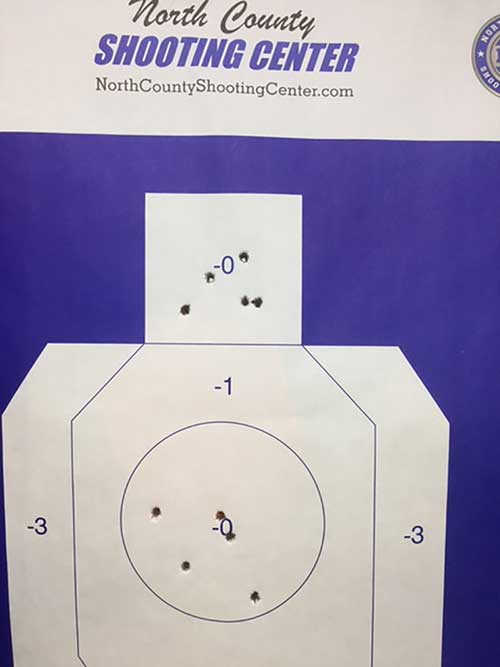
First five shots to the head at five yards followed by five more at 15 yards produced these outstanding results. Beware the relics!
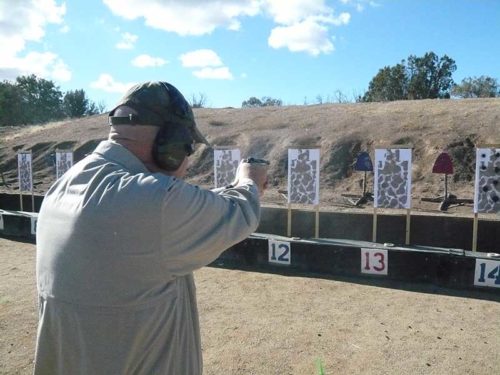
At the end of our writers’ event, Gunsite Range Master Lew Gosnell ran the Savage flawlessly commenting on how helpful he found the larger grip frame.
And while most of that work went towards calibers of interest to law enforcement, that technology has trickled down to the smaller calibers. I have to believe there are other, more modern loads that will work reliably in the Savage. It just might take a while before you can find some on the market.
I don’t know anyone in the industry that would recommend you search for a 100 year old pistol as your primary defensive handgun, with the exception a .45 caliber Model 1911 of course. But keep in mind that while guns like this little Savage may not be the most efficient solution today, in their time they were designed for self-defense and, in good shape, they can still get the job done.
I have no illusions that I’ll ever find extra magazines for my 1917, but remember the Savage’s magazine holds ten rounds, which is twice as many as the ever popular “J” frame revolvers still carried today. (It was ahead of its time in that the rounds are staggered like modern magazines.) That’s an extra cylinder full of ammo instantly available without the delay of a reload.
Given a new, anti-gun administration taking power in all three branches of government, there are indications that ten rounds may be the future maximum capacity allowed for all guns.
Should you ever find yourself without a gun in this gun hostile environment, hundred year old guns may not be subject to the same tyrannical legislation as a bonifide relic. Something like this old Savage might be what comes riding to your rescue. It certainly elevates you from potential prey to serious counter threat.














